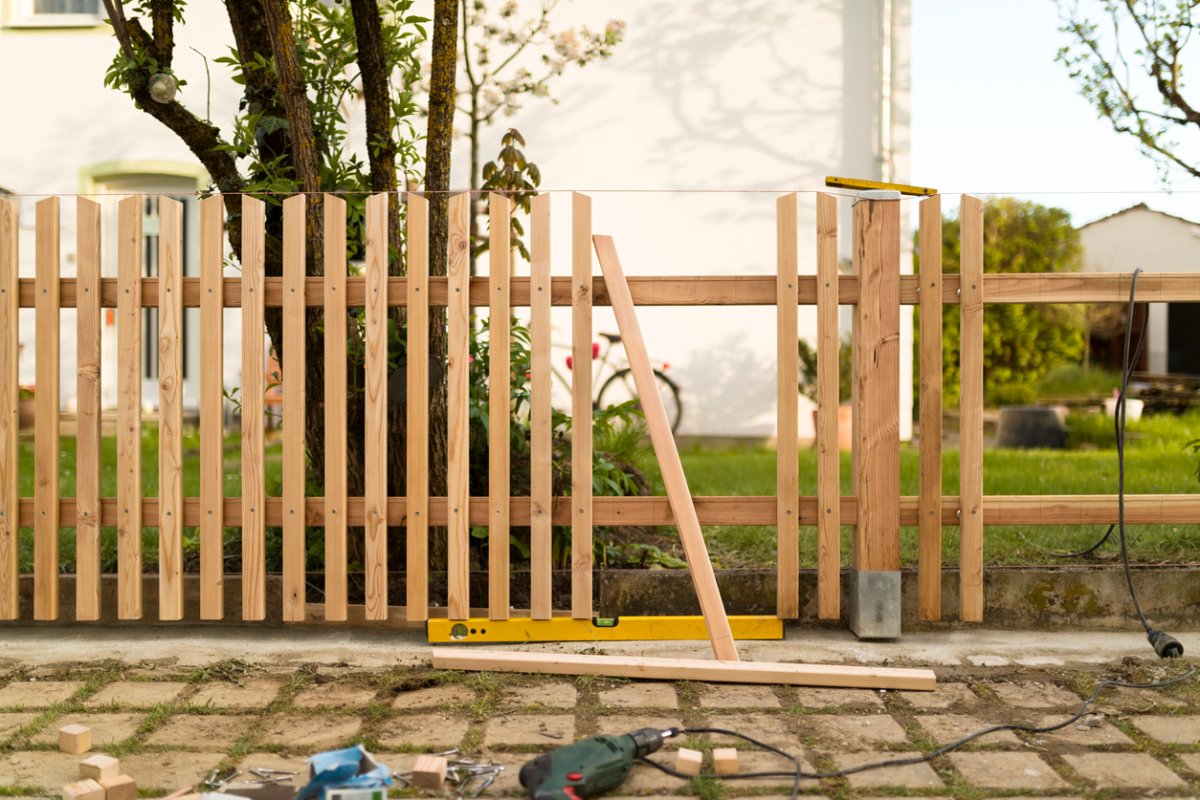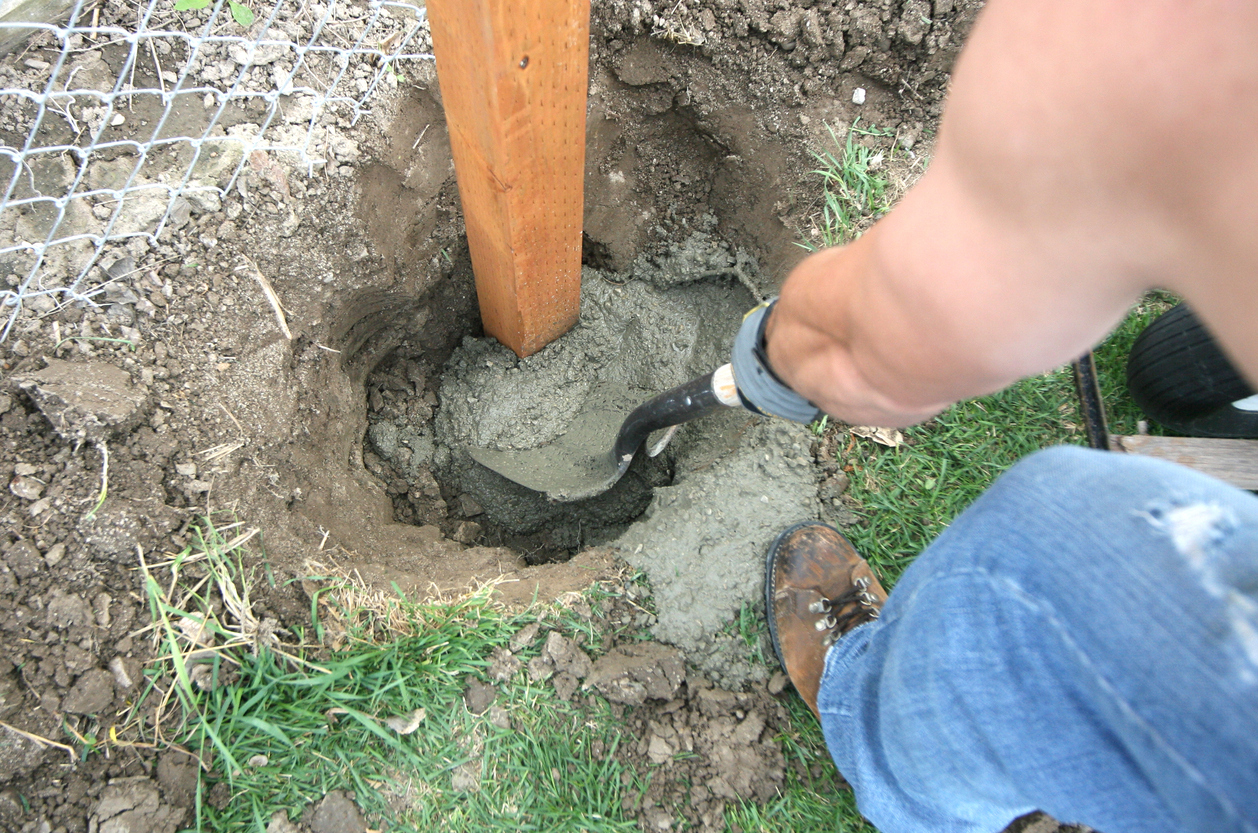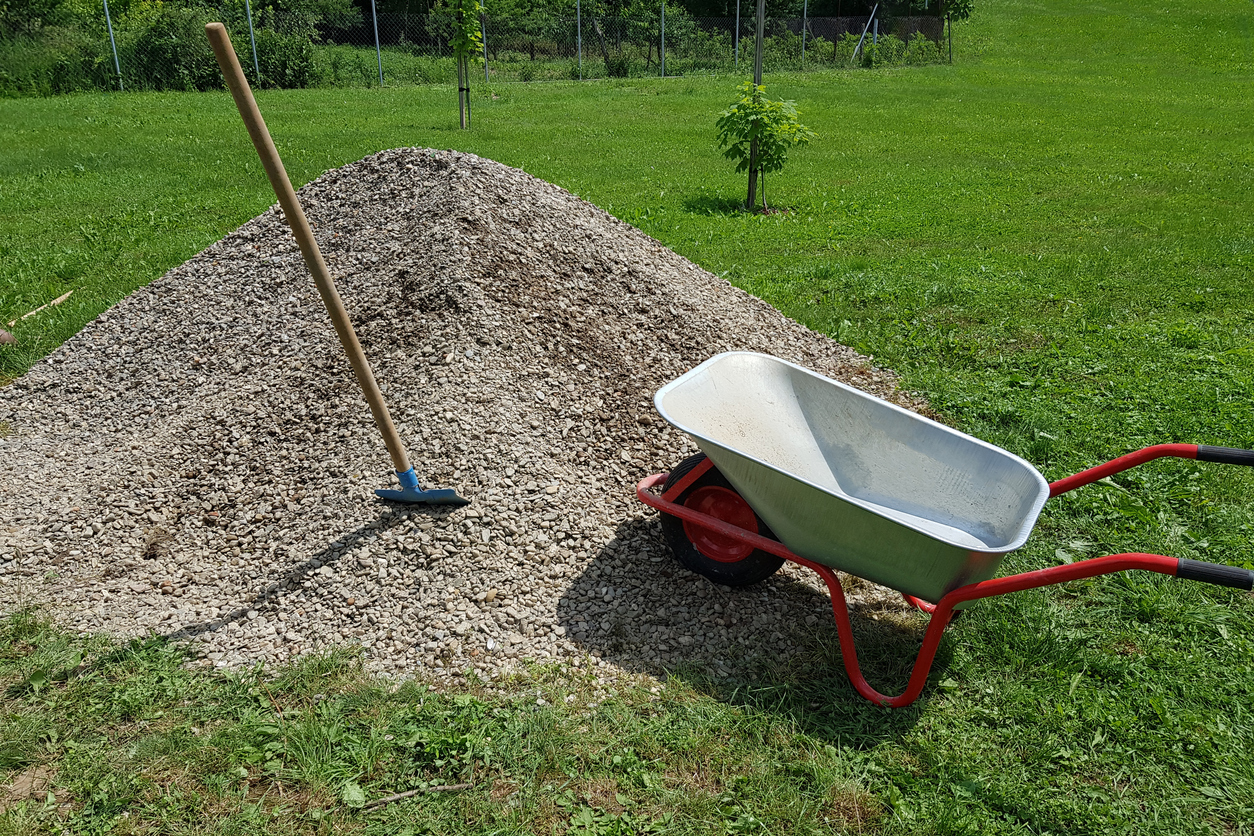

We may earn revenue from the products available on this page and participate in affiliate programs. Learn More ›
Q: The last time I installed a fence it didn’t last long because I underestimated the amount of concrete necessary for the job. I want to get it right this time around, so how much concrete per fence post is necessary to properly secure and support a fence?
A: Finding the right amount of concrete depends on the size of the hole and the size of the post. The diameter of the hole should equal about three times the diameter of the post and the depth of the hole should be about ⅓ to ½ the total length of the pole. With these measurements, it becomes possible to determine the volume of the post hole and the volume of the post within the hole.
To determine how much concrete you’ll need per fence post, simply subtract the volume of the post from the volume of the post hole to find the volume of concrete. Just keep in mind that the post hole needs to be deeper than the frost line and you should also have about 6 inches of gravel in the bottom of the hole for proper drainage and to help protect against frost heaves.

Consider the size of a hole and the post’s depth in the ground.
To accurately calculate the amount of concrete necessary for each post you need to determine the diameter and depth of the hole as well as the diameter and height of the post. The post hole diameter should be about 3 times as large as the diameter of the post, so a 4-inch diameter post would have a 12-inch diameter hole.
The depth of the hole should be about ⅓ to ½ the height of the post. For example, a 6-foot post would require a hole that is at least 2 to 3 feet deep, though the gravel layer and frost line should also be taken into consideration when determining hole depth.
Don’t forget about the frost line for your region.
As noted above, frost lines can be an issue that impacts the necessary depth of the hole. The frost line refers to the specific depth at which the ground freezes completely during the colder months of the year. Depending on where you live, the frost line can range from nonexistent up to 10 feet in depth, so it’s important to check the average frost line depth in your specific location before trying to put up a fence.
On average the frost line for most areas is about 3 feet down, so an appropriate minimum depth would be about 4 feet. In colder locations, the post hole may need to be dug much deeper. This means that if the frost line is typically 6 feet deep in your area a fence post hole should be about 7 feet deep, even if the fence is only going to be 4 or 5 feet above the ground.

Remember to factor in a layer of gravel.
Gravel is an important factor to keep in mind when installing a fence. A 6-inch layer needs to be poured into the bottom of each hole to serve as a barrier between the wooden posts and the moist dirt, making the post less susceptible to frost heaves. The gravel also helps to drain water away from the base of the post, reducing the chance of wood rot.
This 6-inch layer of gravel cannot be overlooked when determining the amount of concrete necessary to fill the hole. While the hole may be 42 inches deep, you need to subtract the 6-inch gravel layer to calculate an accurate concrete amount. So, the 42-inch hole is actually a 36-inch hole for the purpose of determining the amount of concrete.

Tried-and-True Advice
“I found it helpful to use a concrete calculator app on my phone. It’s much easier than doing the math by hand, especially when you’re working with different post sizes and depths. It helped me avoid any guesswork, and ensure I had the right amount of concrete before I even started digging.
The app I use is called Concrete Calculator—the icon is a little red truck on a white background. It’s fairly basic as apps go, but has a sophisticated number of options to help you based on your project; from slab, poured wall, post hole, steps, to block fill and many more. You plug in the measurements of your project and it will give you an estimate of the number of bags of concrete you will need (in either 50-, 60-, or 80-pound bag options), as well as the volume in cubic yards. Nifty stuff!”
—Paul Rankin, Contributing Writer and Editor
Calculate the amount of concrete you need per post.
To determine the specific amount of concrete you’ll need, you will need to calculate the volume of the portion of the post within the hole and the volume of the post hole. Use the following formulas to make those calculations:
Rectangular post/post hole: volume = length x width x depth
Example: 2 x 2 x 36 = 144 cubic inches
Cylindrical post/post hole: volume = radius² x π x depth (π = 3.14)
Example: 1.5² x 3.14 x 36 = 254.34 cubic inches
Remember that to find the radius simply divide the diameter by 2. After finding the post and post hole volumes, simply subtract the post hole volume from the hole volume to find the total volume of concrete necessary to fill the hole.
Concrete amount: volume = hole volume – post volume
Example: 5184 – 144 = 5,040 cubic inches
Convert the total volume to cubic feet or cubic yards as necessary. One cubic foot is equal to 1,728 cubic inches.
Convert to cubic feet: concrete volume in cubic feet = concrete volume in cubic inches / 1728
Example: 4823.04 / 1728 = 2.79 cubic feet
By following each step, you can find exactly how much concrete is needed for each post.
Complete calculation:
Example: An 8-foot-tall round post with a 4-inch diameter should have a 4-foot post hole with a 12-inch diameter. Only half of the post will be in the hole, so the volume of the post should be based on a 4-foot post with a 4-inch diameter.
- Find the radius of the post: radius=diameter / 2
- 4 / 2 = 2 inches
- Find the volume of the post: volume=radius² x π x depth
- 2² x 3.14 x 48 = 602.88 cubic inches
- Find the radius of the post hole: radius=diameter / 2
- 12 / 2 = 6 inches
- Find the volume of the post hole: radius² x π x depth
- 6² x 3.14 x 48 = 5425.92 cubic inches
- Find the volume of concrete: volume = hole volume – post volume
- 5425.92 – 602.88 = 4823.04 cubic inches
- Convert to cubic feet: concrete volume in cubic feet = concrete volume in cubic inches / 1728
- 4823.04 / 1728 = 2.79 cubic feet
For reference, a 40-pound bag of concrete typically yields about 0.3 cubic feet, a 50-pound bag yields 0.37 cubic feet, a 60-pound bag yields 0.45 cubic feet, and an 80-pound bag yields 0.6 feet. This means that in the example above, each post would require about eight 50-pound bags.
Related: The Dos and Don’ts of Setting a Fence Post

Not sure you want to use concrete? Consider other alternatives.
Digging and filling fence posts with concrete can be a long, arduous process. You may have to do at least a few calculations to properly determine the amount of concrete you need per post. Concrete is not the only way to set a fence post, however. DIYers who aren’t interested in using concrete have a few alternatives, including:
- Backfilling the post hole with tightly packed gravel by digging a hole about the size necessary for concrete, then adding about 5 inches of gravel at a time, tamping it down regularly to ensure that the gravel has very little space to move and shift.
- Expanding backfill composites like Fast 2K can be used in place of concrete to set fences in minutes, and at a lower cost.
- For fence post repairs, consider using a fence ground anchor, like the MTB fence post anchor, to secure a cracked or damaged fence post. You can use this instead of digging up the concrete base and replacing the entire post.
